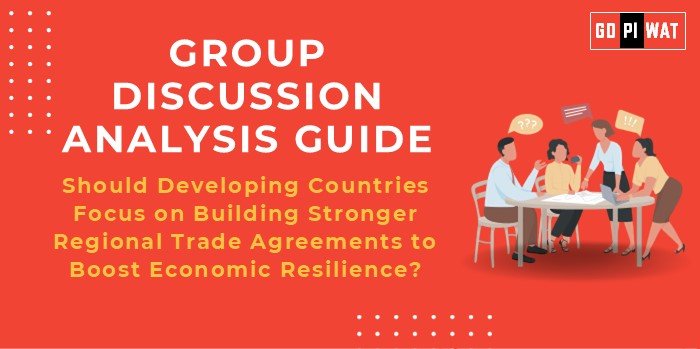📋 Group Discussion Analysis Guide: Should Developing Countries Focus on Building Stronger Regional Trade Agreements to Boost Economic Resilience?
🌐 Introduction to the Topic
Opening Context: In an increasingly interconnected world, regional trade agreements (RTAs) have emerged as key mechanisms to strengthen economic resilience by fostering economic cooperation, reducing trade barriers, and enhancing market access. For developing countries, RTAs offer a strategic path to collective growth amid global economic uncertainties.
Topic Background: RTAs have gained prominence following disruptions caused by the COVID-19 pandemic and shifts in global trade dynamics. Initiatives such as the African Continental Free Trade Area (AfCFTA) and the Regional Comprehensive Economic Partnership (RCEP) exemplify this focus.
📊 Quick Facts and Key Statistics
- 🌍 Global RTAs: Over 350 RTAs are currently active worldwide (WTO, 2023).
- 📈 Trade Growth: RTAs account for over 50% of global trade.
- 💰 Economic Potential: AfCFTA is projected to boost Africa’s GDP by $450 billion by 2035 (World Bank).
- 📊 Resilience Factor: Intra-Asian trade supported 65% of the region’s recovery during the COVID-19 pandemic.
- 🌐 Developing Economies: RTAs represent 60% of exports for developing nations.
🧑🤝🧑 Stakeholders and Their Roles
- 🏛️ National Governments: Negotiate agreements and ensure domestic policies align with regional goals.
- 🌐 Regional Organizations: Facilitate coordination and dispute resolution (e.g., ASEAN, African Union).
- 🏢 Private Sector: Drive innovation and cross-border investments.
- 🌍 International Institutions: Provide financial and technical support (e.g., World Bank, WTO).
🏆 Achievements and Challenges
🎯 Achievements:
- Economic Diversification: ASEAN countries reduced dependency on external trade with intra-regional trade growing to 25%.
- Market Expansion: RCEP created the world’s largest trading bloc, encompassing 30% of global GDP.
- Trade Efficiency: Central American Integration System improved trade facilitation, reducing costs by 20%.
- Resilience: MERCOSUR members achieved relative economic stability during global crises.
⚠️ Challenges:
- Asymmetric Benefits: Smaller economies often gain less, as seen in SADC (Southern African Development Community).
- Non-Tariff Barriers: Persistently high across many RTAs.
- Political Instability: Tensions within blocs like SAARC hinder cooperation.
📋 Structured Arguments for Discussion
- Supporting Stance: “Stronger RTAs enable developing nations to withstand global shocks, as seen during the pandemic recovery in ASEAN.”
- Opposing Stance: “RTAs often exacerbate inequalities, disproportionately benefiting larger economies.”
- Balanced Perspective: “While RTAs offer growth opportunities, their success depends on equitable frameworks and addressing domestic disparities.”
💬 Effective Discussion Approaches
- 💡 Opening Approaches:
- Begin with statistics about RTAs’ contribution to global trade.
- Highlight a successful regional initiative (e.g., ASEAN, AfCFTA).
- Discuss the impact of global crises on trade and resilience.
- 💡 Counter-Argument Handling:
- Example: “While RTAs can marginalize smaller economies, capacity-building measures like technology transfer and financial support can bridge gaps.”
📈 Strategic Analysis of Strengths and Weaknesses
Strengths:
- Economic diversification.
- Increased market access.
- Enhanced resilience.
Weaknesses:
- Dependence on larger economies.
- Implementation barriers.
Opportunities:
- Green economy initiatives.
- Technological partnerships.
Threats:
- Global protectionism.
- Geopolitical tensions.
📚 Connecting with B-School Applications
- Real-World Applications: RTAs offer case studies for understanding global supply chains, economic cooperation, and resilience strategies.
- Sample Interview Questions:
- 🧐 “How can RTAs foster innovation in developing countries?”
- 📘 “Evaluate the role of RTAs in achieving SDGs.”
- Insights for Students: RTAs can inform policy frameworks, business expansion strategies, and cross-border operational challenges.


